The African warblers are a newly erected family, Macrosphenidae, of songbirds. Most of the species were formerly placed in the Old World warbler family Sylviidae, although one species, the Rockrunner, was placed in the babbler family Timaliidae. A series of molecular studies of the Old World warblers and other bird families in the superfamily Sylvioidea (which includes the larks, swallows and tits) found that the African warblers were not part of the family Sylviidae but were instead an early offshoot (basal) to the entire Sylvioidea clade.
The African warblers inhabit a range of habitats in sub-Saharan Africa. These range from primary rainforest to forest edge and open woodland habitats, wooded savanna to arid scrubland and bushland in the crombecs, rocky arid scree areas and grassland for the Rockrunner, and grassland for the Moustached Grass Warbler and Cape Grassbird. The family is overwhelmingly non-migratory.
The African warblers range in size from the smaller crombecs, which measure 8 cm in length, to the Cape Grassbird, which measures 19–23 cm in length and the Moustached Grass Warbler which weighs 29–40 grams. There is considerable difference in appearance between the genera; for example the two grass warblers and Victorin's Warbler possess long graduated tails, whereas the crombecs have tails of which barely extend beyond the tail coverts and folded wings.
The African warblers are insect eaters, and take a range of insect prey. The crombecs feed in the canopy and in bushes, either as singles or pairs and sometimes in small groups, whereas the other species are more terrestrial in their habits. Where two species co-occur, such as the Red-faced Crombec and the Long-billed Crombec over parts of their range, niche partitioning occurs, with one species feeding in the canopy and the other species feeding lower down in the bushes and trees. Some species of crombec have been reported to join mixed-species feeding flocks.
Breeding is seasonal and usually timed to coincide with the end of the dry season and beginning of the rainy season; in species with large ranges this can lead to considerable variation as to the exact timing. The African warblers are territorial and monogamous. Nest design varies within the family; the crombecs construct deep pocket shaped nests suspended from a branch; whereas the Victorin's Warbler, Cape Grassbird and Moustached Grass Warbler construct cup nests weaved from grass.
Africa Wild Bird Book
Family Macrosphenidae (Crombecs, African Warblers) Index
Family Macrosphenidae (Crombecs, African Warblers)
Melocichla mentalis Moustached Grass Warbler 663
Sphenoeacus afer Cape Grassbird 661
Achaetops pycnopygius Rockrunner 662
Sylvietta whytii Red-faced Crombec 650
Sylvietta rufescens Long-billed Crombec 651
Sylvietta ruficapilla Red-capped Crombec 652
Cryptillas victorini Victorin's Warbler 641
Melocichla mentalis Moustached Grass Warbler 663
Sphenoeacus afer Cape Grassbird 661
Achaetops pycnopygius Rockrunner 662
Sylvietta whytii Red-faced Crombec 650
Sylvietta rufescens Long-billed Crombec 651
Sylvietta ruficapilla Red-capped Crombec 652
Cryptillas victorini Victorin's Warbler 641
Cape Grassbird
661. Cape Grassbird Sphenoeacus afer (Grassvoël)
Order: Passeriformes. Family: Macrosphenidae
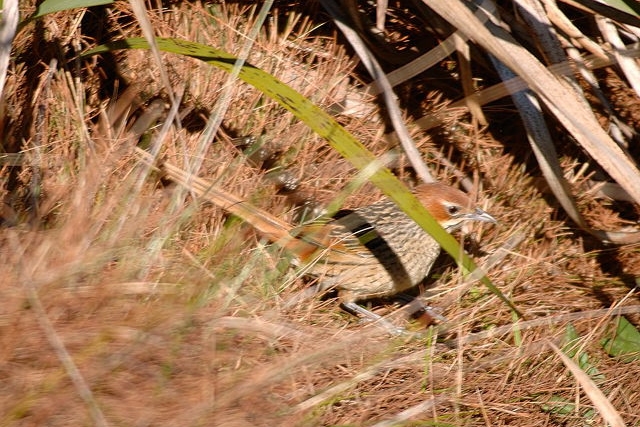
Description
Length 19-23 cm, mass 27-34 g. Chestnut headed bird withlong, pointed, straggly tail, streaked back and pale streaked underparts. Distinctive malar & moustachial stripes.
Adult: Crown and ear coverts rusty red, except for white around the eye. Streaked black on hindcrown and nape. There are two black malar stripes on each side of the pale buff throat. The back is black streaked buff and the rump is rufous. The underparts are buff with black streaks on the flanks. The tail is rufous and fairly long, often looking untidy as the retrices have pointed tips. The sexes are similar.
Immature: Similar to the adult, but duller, and with dark streaks on the crown.
Similar species: Distinguished from the similar Moustached Grass-Warbler by its two malar stripes, heavily streaked back, and long, straggly tail.
Distribution
Endemic to southern Africa, with the bulk of its population in the Western Cape, Eastern Cape, KwaZulu-Natal, Lesotho, Swaziland and Lempopo Province; it also occurs in Zimbabwe’s eastern highlands.
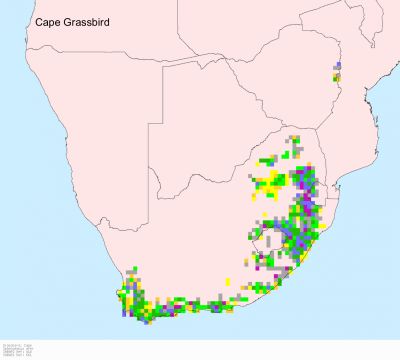
Habitat
Fynbos and rank grasslands on mountain slopes. It generally prefers habitats with restios, rank grasses or ferns, such as fynbos and grassland. It also occupies montane forest edges with Bracken (Pteridium aqualinum) and Brier (Smilax anceps).
Diet
Mostly insects, such as beetles, grasshoppers and caterpillars, doing most of its foraging on the ground beneath vegetation.
Breeding
This species is monogamous, pairing for life. The female builds the nest, which is a bowl built of twigs, grass blades, leaves, lined with finer plant material. It is typically concealed near the ground in a tussock of grass or Restio, or just in some tangled vegetation. Egg-laying season is from about July-December in the Western Cape, elsewhere it is from roughly October-April, peaking from October-December. It lays 2-3 eggs, which are incubated solely by the female for approximately 14-18 days. The chicks are fed by both adults, leaving the nest after about 14-16 days.
Call
Strong musical burst of warbling, chu-tee-ree-chwiddly-chwiddly-chwiddly-chreeu. Listen to Bird Call.
Status
Common resident.
Order: Passeriformes. Family: Macrosphenidae

Description
Length 19-23 cm, mass 27-34 g. Chestnut headed bird withlong, pointed, straggly tail, streaked back and pale streaked underparts. Distinctive malar & moustachial stripes.
Adult: Crown and ear coverts rusty red, except for white around the eye. Streaked black on hindcrown and nape. There are two black malar stripes on each side of the pale buff throat. The back is black streaked buff and the rump is rufous. The underparts are buff with black streaks on the flanks. The tail is rufous and fairly long, often looking untidy as the retrices have pointed tips. The sexes are similar.
Immature: Similar to the adult, but duller, and with dark streaks on the crown.
Similar species: Distinguished from the similar Moustached Grass-Warbler by its two malar stripes, heavily streaked back, and long, straggly tail.
Distribution
Endemic to southern Africa, with the bulk of its population in the Western Cape, Eastern Cape, KwaZulu-Natal, Lesotho, Swaziland and Lempopo Province; it also occurs in Zimbabwe’s eastern highlands.

Habitat
Fynbos and rank grasslands on mountain slopes. It generally prefers habitats with restios, rank grasses or ferns, such as fynbos and grassland. It also occupies montane forest edges with Bracken (Pteridium aqualinum) and Brier (Smilax anceps).
Diet
Mostly insects, such as beetles, grasshoppers and caterpillars, doing most of its foraging on the ground beneath vegetation.
Breeding
This species is monogamous, pairing for life. The female builds the nest, which is a bowl built of twigs, grass blades, leaves, lined with finer plant material. It is typically concealed near the ground in a tussock of grass or Restio, or just in some tangled vegetation. Egg-laying season is from about July-December in the Western Cape, elsewhere it is from roughly October-April, peaking from October-December. It lays 2-3 eggs, which are incubated solely by the female for approximately 14-18 days. The chicks are fed by both adults, leaving the nest after about 14-16 days.
Call
Strong musical burst of warbling, chu-tee-ree-chwiddly-chwiddly-chwiddly-chreeu. Listen to Bird Call.
Status
Common resident.
Dewi
What is the good of having a nice house without a decent planet to put it on? (H D Thoreau)
What is the good of having a nice house without a decent planet to put it on? (H D Thoreau)
Cape Grassbird Photos
661. Cape Grassbird Sphenoeacus afer (Grassvoël)
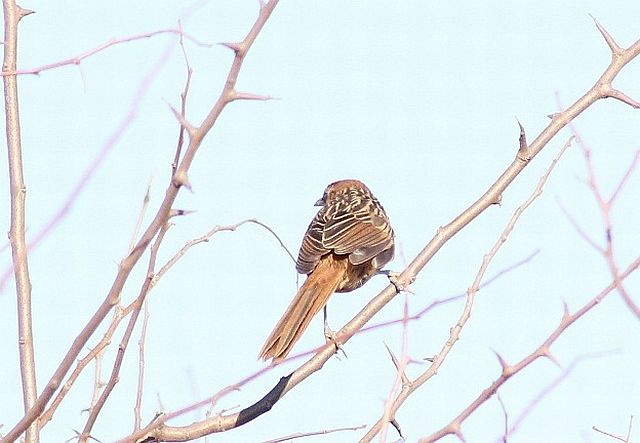 © Amoli
© Amoli
Rietvlei Nature Reserve, Gauteng
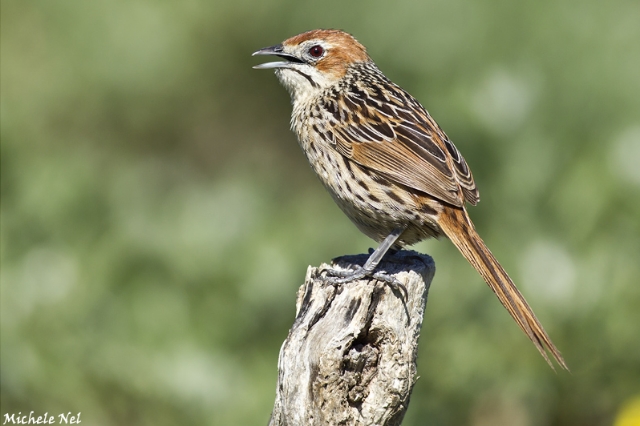 © Michele Nel
© Michele Nel
Kirstenbosch National Botanical Garden, Cape Town
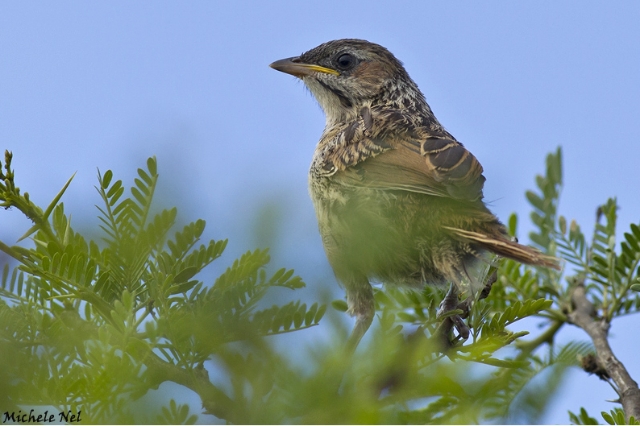 © Michele Nel
© Michele Nel
Juvenile
Links:
Species text Sabap1
Sabap2
 © Amoli
© AmoliRietvlei Nature Reserve, Gauteng
 © Michele Nel
© Michele NelKirstenbosch National Botanical Garden, Cape Town
 © Michele Nel
© Michele NelJuvenile
Links:
Species text Sabap1
Sabap2
Dewi
What is the good of having a nice house without a decent planet to put it on? (H D Thoreau)
What is the good of having a nice house without a decent planet to put it on? (H D Thoreau)
-
Michele Nel
- Posts: 1994
- Joined: Mon Sep 10, 2012 10:19 am
- Country: South Africa
- Location: Cape Town
- Contact:
Rockrunner
662. Rockrunner (Formerly known as the Damara Rockjumper) Achaetops pycnopygius (Rotsvoel)
Order: Passeriformes. Family: Macrosphenidae
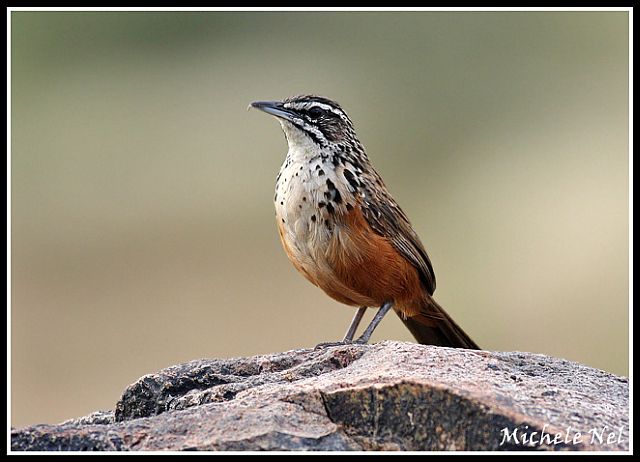 © Michele Nel
© Michele Nel
Description
This large ground dwelling warbler has a heavily streaked, dark back and a white breast spotted with black at the sides. The belly and undertail is rich rufous. The female is more extensive tawny on belly.
Juveniles are duller and have weaker markings.
Similar species: Distinguished from the Cape Grassbird by its shorter, rounded tail, by lacking the chestnut cap and by having chestnuts belly and flanks.
Distribution
Near endemic to southern Africa, with its population centered on west-central Namibia, extending marginally into southern Huila Province of Angola. The Rockrunner is found in central and northwestern regions of Namibia as far north as Opuwo, and its 59 000 km2 range stretches eastwards to the Waterberg Plateau Park, where it is particularly common.
Habitat
It is fairly common yet localised, generally preferring hillsides, scree slopes and rocky outcrops.
Diet
It does almost all of its foraging on the ground, pretty much exclusively eating invertebrates, such as grasshoppers and caterpillars.
Breeding
Monogamous and territorial. The nest is an open cup built of grass of various lengths, with fine grass stems in the inside and more coarse stems on the outside. It is typically woven into the centre of a large grass tuft, only visible from above. Egg-laying season is from November-March. It lays 2-3 eggs, usually 3 eggs, which were incubated for 15 in one observation. The chicks are fed by both adults, leaving the nest before they can fly and hiding in the nearby vegetation and rocks.
Call
Rich robin-like warbles and trills. A hollow melodious rooodle-trrooodlee. Listen to Bird Call.
Status
Fairly common but localised near-endemic.
Order: Passeriformes. Family: Macrosphenidae
 © Michele Nel
© Michele NelDescription
This large ground dwelling warbler has a heavily streaked, dark back and a white breast spotted with black at the sides. The belly and undertail is rich rufous. The female is more extensive tawny on belly.
Juveniles are duller and have weaker markings.
Similar species: Distinguished from the Cape Grassbird by its shorter, rounded tail, by lacking the chestnut cap and by having chestnuts belly and flanks.
Distribution
Near endemic to southern Africa, with its population centered on west-central Namibia, extending marginally into southern Huila Province of Angola. The Rockrunner is found in central and northwestern regions of Namibia as far north as Opuwo, and its 59 000 km2 range stretches eastwards to the Waterberg Plateau Park, where it is particularly common.
Habitat
It is fairly common yet localised, generally preferring hillsides, scree slopes and rocky outcrops.
Diet
It does almost all of its foraging on the ground, pretty much exclusively eating invertebrates, such as grasshoppers and caterpillars.
Breeding
Monogamous and territorial. The nest is an open cup built of grass of various lengths, with fine grass stems in the inside and more coarse stems on the outside. It is typically woven into the centre of a large grass tuft, only visible from above. Egg-laying season is from November-March. It lays 2-3 eggs, usually 3 eggs, which were incubated for 15 in one observation. The chicks are fed by both adults, leaving the nest before they can fly and hiding in the nearby vegetation and rocks.
Call
Rich robin-like warbles and trills. A hollow melodious rooodle-trrooodlee. Listen to Bird Call.
Status
Fairly common but localised near-endemic.
-
Michele Nel
- Posts: 1994
- Joined: Mon Sep 10, 2012 10:19 am
- Country: South Africa
- Location: Cape Town
- Contact:
Rockrunner Photos
662. Rockrunner Achaetops pycnopygius (Rotsvoel)
Order: Passeriformes. Family: Macrosphenidae
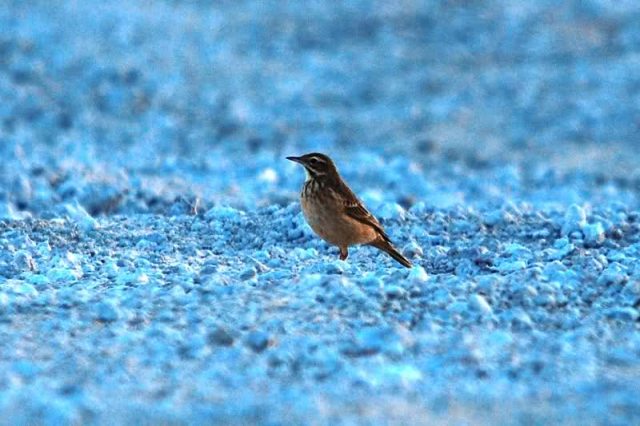 © Mel
© Mel
Auchterlonie Picnic Spot, April 2011
Links:
Species text Sabap1
Sabap2
Biodiversity Explorer
Order: Passeriformes. Family: Macrosphenidae
 © Mel
© MelAuchterlonie Picnic Spot, April 2011
Links:
Species text Sabap1
Sabap2
Biodiversity Explorer
Long-billed Crombec
651. Long-billed Crombec Sylvietta rufescens (Bosveldstompstert)
Order: Passeriformes. Family: Macrosphenidae
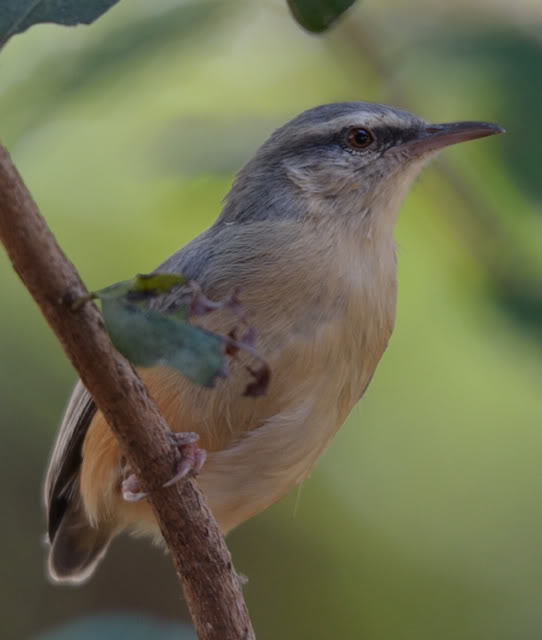 © BluTuna
© BluTuna
Description
This small, plump warbler has a height of 10-12 cm and weighs 9-13 g. Tail very short; appears tailless in the field. Its upperparts are brownish grey to blueish grey and underparts tawny cinnamon to cinnamon buff. The eyebrow is whitish to pale tawny, contrasting with a dark eye-stripe. Its head is grey while the bill is black. The Sylvietta rufescens has brown eyes. The long slightly curved bill is blackish.
The sexes are similar, and the juvenile resembles the adult.
Similar species: It lacks the chestnut breatband and ear patches of the Red-capped Crombec and is told from the Red-faced Crombec by the longer bill, brownish (not ashy grey) upperparts and by lacking the russet tinge to the face.
Distribution
It occurs from eastern DRC, Angola and Zambia south to southern Africa.
Habitat
It is found in arid savanna, mixed-species woodland with well-developed undergrowth, gardens, Acacia thickets, Mopane & Miombo woodland.
Diet
It mainly eats invertebrates (termites, spider, beetles, ticks), supplemented with seeds, nectar and fruit. Often foraging in mixed-species flocks, it gleans food from the leaves and branches of bushes and trees. It hops along branches, twigs and leaves, at times hanging upside-down to inspect and probe crevices. Also digs into termite tunnels in trees.
Breeding
This territorial species is monogamous, pairing for life. The hanging nest is constructed in about 7-10 days, consisting of a bag-like cup of stringy plant fibres, leaves, grass and spider web. Often it is decorated with leaves, rotten wood chips and lumps of spider web and lined with dry grass. It is typically strung from a droopy tree branch or in the depths of a bush. Egg-laying season is from August-March, peaking from September-January. It lays 1-3 white eggs, which are incubated by both sexes for roughly 14 days. The chicks are fed by both parents, leaving the nest after about 14 days. After at least 10 days they become fully independent.
Call
The call is a variable series of tripping chit-chirrit-chirrit-chirrit-chirrit. And a harsh prttt. Listen to Bird Call.
Status
Common resident.
Order: Passeriformes. Family: Macrosphenidae
 © BluTuna
© BluTunaDescription
This small, plump warbler has a height of 10-12 cm and weighs 9-13 g. Tail very short; appears tailless in the field. Its upperparts are brownish grey to blueish grey and underparts tawny cinnamon to cinnamon buff. The eyebrow is whitish to pale tawny, contrasting with a dark eye-stripe. Its head is grey while the bill is black. The Sylvietta rufescens has brown eyes. The long slightly curved bill is blackish.
The sexes are similar, and the juvenile resembles the adult.
Similar species: It lacks the chestnut breatband and ear patches of the Red-capped Crombec and is told from the Red-faced Crombec by the longer bill, brownish (not ashy grey) upperparts and by lacking the russet tinge to the face.
Distribution
It occurs from eastern DRC, Angola and Zambia south to southern Africa.
Habitat
It is found in arid savanna, mixed-species woodland with well-developed undergrowth, gardens, Acacia thickets, Mopane & Miombo woodland.
Diet
It mainly eats invertebrates (termites, spider, beetles, ticks), supplemented with seeds, nectar and fruit. Often foraging in mixed-species flocks, it gleans food from the leaves and branches of bushes and trees. It hops along branches, twigs and leaves, at times hanging upside-down to inspect and probe crevices. Also digs into termite tunnels in trees.
Breeding
This territorial species is monogamous, pairing for life. The hanging nest is constructed in about 7-10 days, consisting of a bag-like cup of stringy plant fibres, leaves, grass and spider web. Often it is decorated with leaves, rotten wood chips and lumps of spider web and lined with dry grass. It is typically strung from a droopy tree branch or in the depths of a bush. Egg-laying season is from August-March, peaking from September-January. It lays 1-3 white eggs, which are incubated by both sexes for roughly 14 days. The chicks are fed by both parents, leaving the nest after about 14 days. After at least 10 days they become fully independent.
Call
The call is a variable series of tripping chit-chirrit-chirrit-chirrit-chirrit. And a harsh prttt. Listen to Bird Call.
Status
Common resident.
Long-billed Crombec Photos
651. Long-billed Crombec Sylvietta rufescens (Bosveldstompstert)
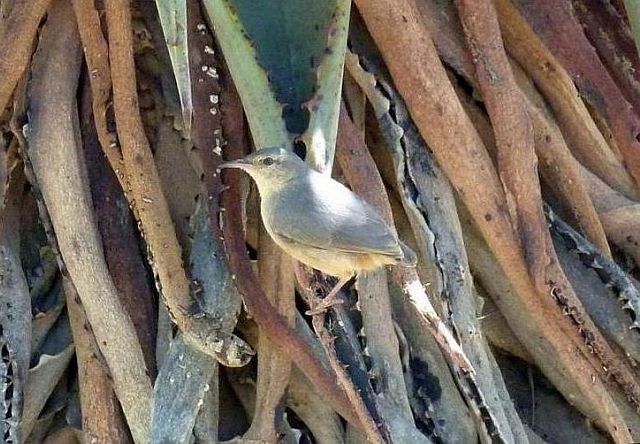 © Toko
© Toko
Bontebok National Park
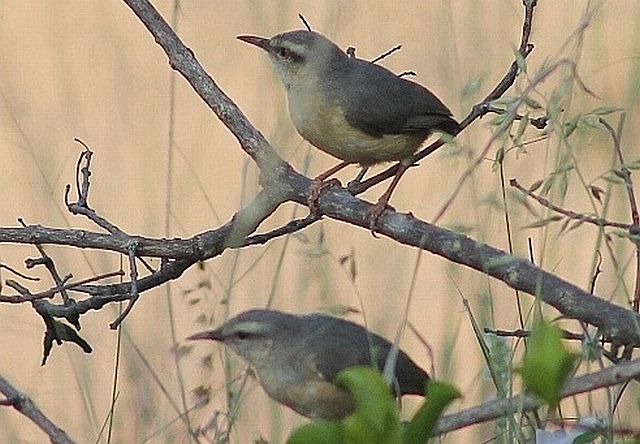 © Amoli
© Amoli
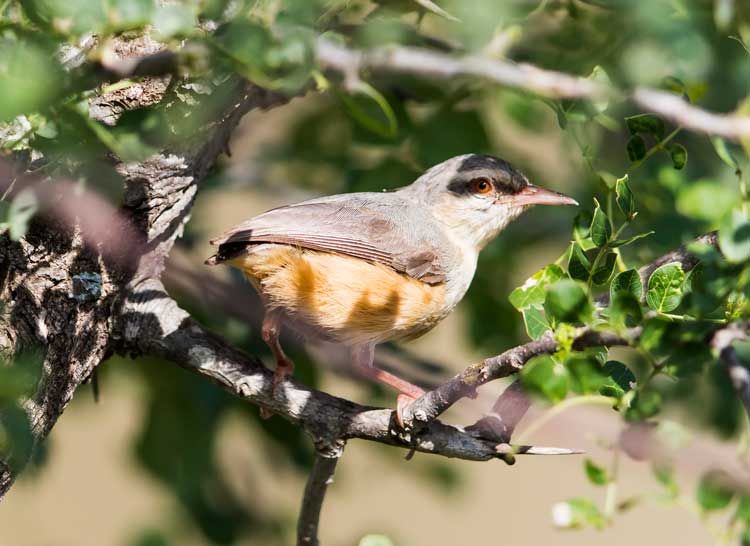 © Pumbaa
© Pumbaa
Kruger National Park
Links:
Sabap2
NEWMAN'S VOELS VAN SA (8ste UIT)
 © Toko
© TokoBontebok National Park
 © Amoli
© Amoli © Pumbaa
© PumbaaKruger National Park
Links:
Sabap2
NEWMAN'S VOELS VAN SA (8ste UIT)
Family Phylloscopidae (Leaf Warblers)
Phylloscopidae is a newly (2006) described family of small insectivorous birds formerly placed in the Old World warbler family Sylviidae. Its members occur in Eurasia and Africa (and the Arctic Warbler breeding east into Alaska). Most live in forest and scrub and frequently catch food on the wing.
The species are of various sizes, often green-plumaged above and yellow below, or more subdued with greyish-green to greyish-brown colours, varying little or not at all with the seasons. The tails are not very long and contain 12 feathers (unlike the similar reed warblers, Abroscopus species, which have 10 tail feathers).
Phylloscopidae contains two genera, Phylloscopus and Seicercus, respectively containing around 55 and 11 species.
The genus Seicercus is distributed in the Indian Subcontinent and eastern Asia.
Leaf warblers the genus Phylloscopus are small insectivorous birds. The genus is closely related to Seicercus and some species have been moved between the two genera in recent classification attempts. These Leaf warblers are active, constantly moving, often flicking their wings as they glean the foliage for insects along the branches of trees and bushes. They forage at various levels within forests, from the top canopy to the understorey. Most of the species are markedly territorial both in their summer and winter quarters. Most are greenish or brownish above and off-white or yellowish below. Compared to some other "warblers", their songs are very simple. Species breeding in temperate regions are usually strongly migratory.
The species are of various sizes, often green-plumaged above and yellow below, or more subdued with greyish-green to greyish-brown colours, varying little or not at all with the seasons. The tails are not very long and contain 12 feathers (unlike the similar reed warblers, Abroscopus species, which have 10 tail feathers).
Phylloscopidae contains two genera, Phylloscopus and Seicercus, respectively containing around 55 and 11 species.
The genus Seicercus is distributed in the Indian Subcontinent and eastern Asia.
Leaf warblers the genus Phylloscopus are small insectivorous birds. The genus is closely related to Seicercus and some species have been moved between the two genera in recent classification attempts. These Leaf warblers are active, constantly moving, often flicking their wings as they glean the foliage for insects along the branches of trees and bushes. They forage at various levels within forests, from the top canopy to the understorey. Most of the species are markedly territorial both in their summer and winter quarters. Most are greenish or brownish above and off-white or yellowish below. Compared to some other "warblers", their songs are very simple. Species breeding in temperate regions are usually strongly migratory.
Family Phylloscopidae (Leaf Warblers) Index
Family Phylloscopidae (Leaf Warblers)
Phylloscopus ruficapilla Yellow-throated Woodland Warbler 644
Phylloscopus trochilus Willow Warbler 643
Phylloscopus ruficapilla Yellow-throated Woodland Warbler 644
Phylloscopus trochilus Willow Warbler 643


